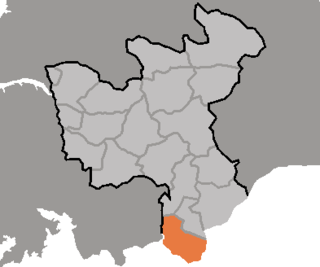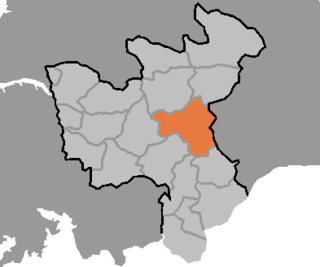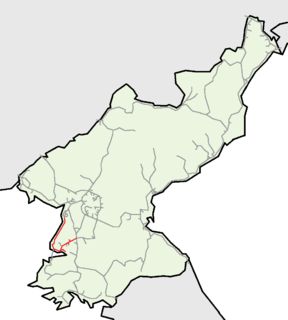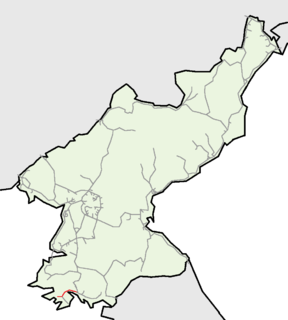
Kaep'ung County is a county in North Hwanghae province, North Korea. Formerly part of the Kaesong urban area, the county was merged with North Hwanghae when Kaesong was demoted in 2003. The area is the site of the royal tombs of kings Kongmin and Wanggon.
Kaep'ung Station is a railway station located in Kaep'ung-ŭp, Kaep'ung County, North Hwanghae province, North Korea. It is on located on the P'yŏngbu Line, which was formed from part of the Kyŏngŭi Line to accommodate the shift of the capital from Seoul to P'yŏngyang; though this line physically connects P'yŏngyang to Pusan via Dorasan, in operational reality it ends at Kaesŏng due to the Korean Demilitarized Zone.
Sariwŏn Ch'ŏngnyŏn Station is the central railway station of Sariwŏn, North Hwanghae province, North Korea. It is on located on the P'yŏngbu Line, which was formed from part of the Kyŏngŭi Line to accommodate the shift of the capital from Seoul to P'yŏngyang; though this line physically connects P'yŏngyang to Pusan via Dorasan, in operational reality it ends at Kaesŏng due to the Korean Demilitarized Zone. It is also the northern terminus of the Hwanghae Ch'ŏngnyŏn Line.
Hwangju Station is a railway station in Hwangju County, North Hwanghae Province, North Korea. It is the junction point of the P'yŏngbu Line, which runs from P'yŏngyang to Kaesŏng, and the Songrim Line, which begins at Hwangju and runs to Songrim.

Chaeryŏng County is a county in South Hwanghae province, North Korea.

Sin'gye County is a county in North Hwanghae province, North Korea. It is a mining district with abandoned molybdenum and copper mines.

The P'yŏngbu Line is an electrified standard-gauge trunk line of the Korean State Railway running from P'yŏngyang to Kaesŏng in North Korea and further south across the DMZ to Seoul in South Korea; the name comes from the two (theoretical) termini of the line: P'yŏngyang and Pusan.

The P'yŏngnam Line is an electrified standard-gauge trunk line of the Korean State Railway in North Korea, linking P'yŏngyang with the port city of Namp'o and the hot springs at P'yŏngnam Onch'ŏn. The length of the line is 89.9 km (55.9 mi).

The Songrim Line is a partially electrified standard-gauge secondary line of the Korean State Railway in South Hwanghae Province, North Korea, running from Hwangju on the P'yŏngbu Line to Songrim.

The Hwanghae Ch'ŏngnyŏn Line is an electrified standard-gauge secondary line of the Korean State Railway in the North and South Hwanghae provinces of North Korea, running from Sariwŏn to Haeju. It connects to the P'yŏngbu Line at Sariwŏn, to the Ŭnnyul Line at Ŭnp'a, to the Paech'ŏn Line at Changbang, and to the Ongjin Line at Haeju. It plays an important role in the transportation of freight and passengers in North and South Hwanghae provinces, serving important mining and industrial areas, as well as one of the DPRK's most important ports for foreign trade.

The Ŭnnyul Line is a non-electrified standard-gauge secondary line of the Korean State Railway in the North and South Hwanghae provinces of North Korea, running from Ŭnp'a to Ch'ŏlgwang. It is an important line in economic terms, connecting the agricultural and ore-producing areas of Kwail and Ŭnnyul counties with the rest of the DPRK.

The Changyŏn Line is a non-electrified standard-gauge secondary line of the Korean State Railway running from Sugyo on the Ŭnnyul Line to Changyŏn, South Hwanghae Province, North Korea.

The Paech'ŏn Line is a partially electrified standard-gauge secondary railway line of the Korean State Railway in South Hwanghae Province, North Korea, running from Changbang on the Hwanghae Ch'ŏngnyŏn Line to Ŭnbit.

The Ongjin Line is a partially electrified standard-gauge secondary line of the Korean State Railway in South Hwanghae Province, North Korea, running from Haeju on the Hwanghae Ch'ŏngnyŏn Line to Ongjin.
Haeju Ch'ŏngnyŏn Station is the central railway station of Haeju City, South Hwanghae Province, North Korea. Haeju Ch'ŏngnyŏn Station is the terminus of Hwanghae Ch'ŏngnyŏn Line and the origin station of Ongjin Line.
The Chosen Railway Company, was a privately owned railway company in Japanese-occupied Korea.
Changbang Station is a railway station in Changbang-ri, Haeju City, South Hwanghae Province, North Korea, on the Hwanghae Ch'ŏngnyŏn Line of the Korean State Railway. It is also the western terminus of the Paech'ŏn Line.
The Sŏhaeri Line or Ryongjŏng Line is a closed non-electrified 762 mm narrow-gauge railway line of the Korean State Railway in South Hwanghae Province, North Korea, running from Ch'ŏlgwang at the junction of the Ŭnnyul and Sŏhae Kammun lines to Ryongjŏng.
The Chŏngdo Line is an electrified standard-gauge secondary line of the Korean State Railway in South Hwanghae Province, North Korea, running from Wangsin on the Ongjin Line to Chŏngdo.














